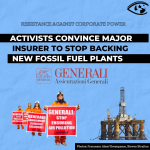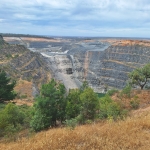Nuclear Renaissance or Nuclear Nightmare?
Thought the Nuclear Power Industry was Dead? Guess again. The Bush Administration is Breathing New Life into Commercial Nukes.
RELATED ARTICLE Protecting Nukes from Liability by Karl Grossman |
Russia and the US have teamed up to launch a new 'Atoms for Peace and Prosperity' Program.-- Dr. Andrei Gagarinski, Kurchatov Institute, Russia |
At the session, Dr. Andrei Gagarinski, director of international affairs at Russias Kurchatov Institute, said his atomic research facility had teamed with the U.S. Department of Energy-owned Sandia National Laboratories to put together "a new Atoms for Peace and Prosperity Program." The program was considered at President George Bushs summit meeting with Russian President Vladimir Putin in May, according to Gagarinski.
In the U.K. in August, Robin Jeffrey, chairman of British Energy, called for a "nuclear renaissance" telling the British Nuclear Engineering Society that "working in partnership [we can] create a financial and commercial framework for a programme of new build."
Nuclear Globalization
Meanwhile, as it prepares for its hoped-for "renaissance," the nuclear industry has globalized:
- British Nuclear Fuels Ltd. has purchased Westinghouse (the worlds largest reactor manufacturer) and ABB/Combustion Engineering (itself the product of an earlier merger of the Swedish ABB and the U.S. corporation Combustion Engineering).
- Siemens, the largest reactor builder in Germany, and Framatome, with a monopoly on construction of French reactors, announced their intent to merge most aspects of their nuclear businesses.
- General Electric (the world's second largest reactor manufacturer after Westinghouse) joined with Mitsubishi to build new atomic plants in Japan.
- Minatom, the giant Russian state-owned nuclear entity, is moving to build new nuclear plants in Russia and internationally.
A handful of giant multinational energy corporations are positioning themselves to become "the robber barons of the 2lst Century," says Michael Mariotte, Executive Director of the Nuclear Information & Resource Service/World Information Service on Energy-Amsterdam (NIRS-WISE Amsterdam). Mariotte added that "perhaps no industry is embracing globalization quite so fervently," in a field "where the stakes are highest, where the threats to all life are most at risk."
Paul Gunter, head of the organizations Reactor Watchdog Project, who attended the "Nuclear Renaissance" conference in Washington, said rather than a renaissance, what is involved is "a relapse into the failed nuclear energy policy" of the past.
George W. Bush: Nuclear President
"If you set aside Three Mile Island and Chernobyl, the safety record of nuclear is really is good."-- Treasury Secretary Paul O'Neill |
The "renaissance" also now comes with what Mariotte says "may be the most ardently pro-nuclear power presidency in U.S. history." The Bush administrations stance on nuclear power is aggressive and minimizes the dangers of atomic technology. As Bushs Secretary of Treasury Paul ONeill has told The Wall Street Journal, "If you set aside Three Mile Island and Chernobyl, the safety record of nuclear is really is good."
The administration struck a close working relationship with the nuclear industry well before taking office. Its energy "transition" advisors included:
- Joseph Colvin, president of the Nuclear Energy Institute (NEI), the lead nuclear industry-funded trade group.
- J. Bennett Johnston who as a senator was a leading
pro-nuclear power figure in Congress and now runs a consulting firm that assists the nuclear industry. - Thomas Kuhn, president of the Edison Electric Institute and former head of the American Nuclear Energy Council, forerunner of the NEI, and a friend of Bush going back to their days at Yale
Representatives of four U.S. utilities involved with nuclear power.
Two weeks after being sworn in, Bush set up a "National Energy Policy Development Group" and appointed Vice President Dick Cheney as its chairman. Its members included ONeill and Andrew Lundquist, who also coordinated the energy "transition" team was named executive director.
"The National Energy Policy Development Group supports the expansion of nuclear energy in the United States as a major component of our National Energy Policy," declared the group's report, issued ten weeks later.
"America," said Bush in unveiling the plan, should "expand a clean and unlimited source of energy: nuclear power."
This National Energy Policy whose recommendations were discussed at length at the Nuclear Renaissance conference - would substantially increase the use of nuclear power in the U.S. both by building new nuclear power plants many on existing nuclear plant sites, and extending the 40-year licenses of currently operating plants by another 20 years each.
Nukes: Exception to the War on Terrorism?
Some observers might think the September 11th terrorist attacks -- and the reported plans by Al Qaeda to strike at U.S. nuclear plants -- might hold up plans for a "nuclear renaissance."
But Richard A. Meserve, chairman of the U.S. Nuclear Regulatory Commission (NRC), struck positive notes at the Nuclear Renaissance conference at which he was a keynote speaker. The NRC was created in 1975 to impartially regulate nuclear power replacing the U.S. Atomic Energy Commission, which Congress deemed to be in conflict of interest being set up to both promote and regulate nuclear power.
"First, the physical protection at nuclear power plants was strong before September 11th. I am aware of no other industry that has had to satisfy the tough requirements that the NRC has had in place for a quarter of a century," stated Meserve.
"Secondly, there have been no specific credible threats of a terrorist attack on nuclear power plants since September 11th," he added.
"Third" Meserve concluded, "in light of the events of September 11th, the NRC has recognized the need to reexamine past security strategies to ensure that we have the right protections in place for the long term."
"The agency could not have presented the situation farther from the truth," noted Gunter of the Reactor Watchdog Project. "Before September 11th, the industry and NRC were mired in an endless dialogue on security deficiencies and the rising cost of safeguarding nuclear power plants" he said. And federal security exercises conducted since 1991 led to "failing grades" half the time, according to Gunter.
Gunter said that after the September 11th attacks, the NRC closed down its formal security exercise program. "The vulnerability of attacks from the air and the water were never evaluated," he explained.
"Contrary to Dr. Meserves remarks, nuclear power plants remain both structurally and programmatically vulnerable to sophisticated and premeditated acts of terrorism," according to the head of the watchdog group.
Corporate Welfare
Also making a presentation at the "Nuclear Renaissance" conference was Westinghouse Vice President for New Plants Ernie H. Kennedy who described "the post-TMI phase" for the nuclear industry as a "collapse of new plant orders, cancellation of existing orders" and "sharply increasing O&M [operation and maintenance] costs." But, he said, the nuclear industry in the 1990s had been busy "getting the house in order" and "preparing for the renaissance 2000s." Now, said Mr. Kennedy, there is "slow but sustained improvement in public acceptance" and "improved political support."
Gail H. Marcus, Bush administration appointee as principal deputy director of the U.S. Department of Energy, who is also president of the pro-industry American Nuclear Society, began her presentation by quoting from report of the National Energy Policy Development Group. She said new nuclear power plants would be built under a "cost-shared" arrangement between the federal government and utilities. This will be combined, she said, with the Department of Energys "Early Site Permit" or expedited nuclear plant process on three projects soon to be advanced.
The "cost-shared" and "Early Site Permit" arrangements will be initially used in construction by:
- Dominion Energy for new nuclear plant at the current North Anna nuclear plant site in Virginia
- Entergy for a new nuclear plant at the Grand Gulf nuclear plant site in Mississippi
- Excelon for a new nuclear plant at the Clinton nuclear plant site in Illinois.
Marcus said the new plants were expected to come on line by 2005 and some, or all, of the "advanced" nuclear plant would be deployed by 2010.
The Lone Dissenter
The sponsors of The Nuclear Renaissance Conference -- Framatome, Canadian reactor manufacturer AECL Technologies, Winston & Strawn, a Washington law firm that represents clients involved with nuclear power, and EXCEL, a provider of services for U.S. and international commercial nuclear power facilities -- allowed one anti-nuclear advocate to make a presentation.
"The real question is: How should the nuclear industry be held responsible for the health and environmental disasters that it has created?"-- Winonah Hauter, Critical Mass Energy and Environment Program, Public Citizen |
Winonah Hauter, director of the Critical Mass Energy and Environment Program at Ralph Naders Public Citizen, spoke as part of a panel discussion titled "How Should the Environmental Benefits of Nuclear Assets Be Valued?"
"The answer to the question about valuing the benefits of nuclear assets is simple. There are none," Hauter stated. Then she fired off questions of her own.
"The real questions that should have been asked at this conference is: How should the nuclear industry be held responsible for and required to bear the full cost of the health and environmental disasters that it has created? Why are our government agencies lapdogs for the industry? How has the industry bought public policy?"
As to the claim of nuclear proponents at the conference that atomic plants assist in offsetting global warming, Hauter pointed out that the nuclear fuel cycle creates a vast amount of greenhouse gases.
"An elaborate energy-intensive process of uranium mining, milling and enrichment must take place before the fuel rods can even be fabricated. All of these processes use massive quantities of fossil fuels. The manufacture and construction of reactors require more fossil fuels. And [as to] the back end of the fuel cycleif the industry is successful in dumping waste on the unwilling citizens of Nevadait will take more fossil fuel to move thousands of shipments."
"And even if nuclear energy didnt use fossil fuel," she went on "the regular radiation releases from plants would way offset any benefit."
Hauter challenged the industry public relations campaign promoting nuclear energy as a "clean" alternative to fossil fuels. "Nuclear power plants are not cost-effective, which means they can only be built if nuclear corporations are allowed special dispensation from the government. Let me put that more clearly: the industry has to feed at the trough of taxpayer money to survive. So the industry is looking for new ways to justify its existence."
Activists Crash the Party
The Nuclear Renaissance Conference received uninvited guests, too. Activists from Greenpeace crashed the conference with a 200-pound ice sculpture depicting a nuclear plant melting. Carved into the ice statue were the words No New Nukes.
"Greeenpeace is putting plans for any nuclear renaissance on ice" said Jim Riccio, nuclear policy analyst for Greenpeace. "Despite benefiting from millions of dollars of government subsidies, nuclear power plants are still too expensive to build, too dangerous to operate and too vulnerable to potential terrorist attacks."
The activists also distributed a broadside at the conference called The No New Nukes Times. A New York Times-like front page featured stories with headlines such as, "Once Touted As Too Cheap To Meter Now Too Costly to Matter" and "Dr. Strangelove Hands Plutonium Over to Homer Simpson."
Conference attendee Gunter of NIRS/WISE Amsterdam commented that in order to bring about a "renaissance" the nuclear industry faces a number of obstacles. Chief among them he cited "increased public mistrust and growing opposition to a proliferation of new nukes."
"The meltdown of the industry plans hatched in the early 1970s to build a thousand reactors by the year 2000 was in large part the result of a public unwilling to swallow the lies of nuclear industrialists and their political cronies," said Gunter.
"New construction on the enormous scale the industry must contemplate will provide the anti-nuclear movement with the opportunity to raise concerns over the vulnerability and costs of security, the proliferation of an already unmanageable nuclear waste problem and the inherent risk of an accident associated with the most expensive and dangerous process conceivable for boiling water to make electricity" according to the head of the watchdog group.
Karl Grossman, professor of journalism at the State University of New York/College at Old Westbury, is the author of books on nuclear technology including Cover Up: What You ARE NOT Supposed To Know About Nuclear Power and host of numerous television programs on atomic energy available from EnviroVideo.
- 107 Energy



